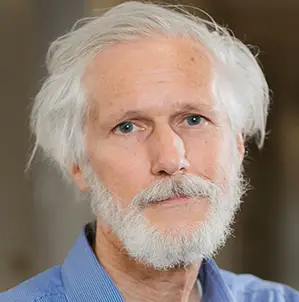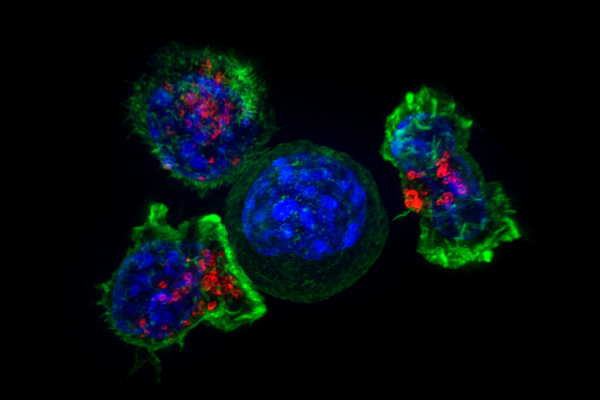Patrick Hogan, Ph.D., studies cells at the nano level – seeking to understand how protein-protein interactions on the submicroscopic scale can have gargantuan impacts on human health and disease. “My laboratory is interested in the processes by which proteins interact with each other and with DNA to turn on genes in the nucleus. That’s the whole secret of how T cells work,” he said, referring to the body’s infection-fighting white blood cells. “The interactions we study are subtle but can be the key to human health and disease.” Dr. Hogan researches how calcium entry into T cells turns on the genes that are necessary to fight infections and cancers. “This flows from my earlier work in neurobiology,” he said, “where we tried to understand how pain sensory neurons are activated. That was my apprenticeship in how calcium and other ions enter cells, and how cells perceive and respond to signals.” His laboratory made a landmark discovery in 2006, when they studied a protein, ORAI1, that was mutated in two children with immune deficiency, making the children unusually susceptible to life-threatening infections. Dr. Hogan related the immune deficiency directly to calcium by showing that ORAI1 forms the pore of the calcium entry channel in T cells. “The hopeful lesson we take from these immunodeficient patients is that it may be possible to develop new therapies for transplant rejection and autoimmune disorders by targeting the calcium channel,” he said.
Hogan Lab
Patrick Hogan, Ph.D.
Professor
Center for Autoimmunity and InflammationCenter for Cancer Immunotherapy
“
In the last few years, physics, chemistry, and engineering have given us incisive new tools that can be applied to biological and medical problems. The challenge is to deploy these tools creatively to increase our understanding of cell biology and to discover treatments for human disease.
Featured Publications
Sep 30, 2019
- Nat Rev Immunol
Blank CU, Haining WN, Held W, Hogan PG, Kallies A, Lugil E, Lynn RC, Philip M, Rao A, Restifo NP, Schietinger A, Schumacher TN, Schwartzberg PL, Sharpe AH, Speiser DE, Wherry EJ, Youngblood BA, Zehn D
Jun 18, 2019
- Proc Natl Acad Sci U S A
Seo H, Chen J, González-Avalos E, Samaniego-Castruita D, Das A, Wang YH, López-Moyado IF, Georges RO, Zhang W, Onodera A, Wu CJ, Lu LF, Hogan PG, Bhandoola A, Rao A
He L, Zhang Y, Ma G, Tan P, Li Z, Zang S, Wu X, Jing J, Fang S, Zhou L, Wang Y, Huang Y, Hogan PG, Han G, Zhou Y
Lab Members
Sri Kanth Battu, Ph.D.
Postdoctoral Fellow
Barsha Dash, Ph.D.
Postdoctoral Fellow
Hannah Drum
Research Tech I

Patrick Hogan
Professor

Arlet Lara Custodio
Research Tech I
Yi-Tsang Lee, Ph.D.
Postdoctoral Fellow

Laura Zhao
UCSD Graduate Student
From the Lab
- Research News
New LJI research could keep cancer-fighting T cells from burning out before the job is done
- Research News
Chemical screen proves feasibility of modulating factor at the hub of immune system's decision to attack or retreat
- Research News
La Jolla Institute scientists show that deleting troublesome proteins in a mouse model can shrink tumors and prolong survival
Contact Lab Members
Use the dropdown menu on the right to contact individual lab members.
For interview requests, please contact LJI’s Chief Communications Officer by calling 858.752.6640 or via email at communications@lji.org.
Please send general inquiries to contact@lji.org.



